The Frozen Autumn was originally founded in the spring of 1993 in Turin, Italy as the one-man Darkwave project of vocalist/keyboardist, Diego Merletto. In an interview, he once elaborated on the significance behind the name of this project, stating the following: "I was really fond of the idea of a 'frozen autumn' as the vision of a melancholic season but at the same time 'put under ice' like a picture of my emotions". Guitarist Claudio Brosio would gain membership in The Frozen Autumn a short time after in order to assist with studio sessions and live performances. Not before long, the Italian duo found themselves at home recording a five-track demo entitled "Oblivion". They also eventually performed at their very first concert in Ferrarra, Italy supporting the German Darkwave group, Endraum, who coincidentally had just initiated a new record label (Weisser Herbst) around this time. Endraum actually happened to be fond of The Frozen Autumn's music, so as a result, a record contact was offered to the two individuals and they accepted, officially debuting in 1995 with "Pale Awakening". The breathtaking artwork which features a radiant, cerulean firmament shrouded by clouds of silver and ebony (with what appears to be some kind of crown-shaped dome or castle protruding in the midst of them) perfectly represents the musical content and its atmospheric, ethereal and lugubrious nature. Upon first listening to "Pale Awakening", it also quickly becomes apparent that this duo gathered their inspiration from a myriad of Ethereal Darkwave, Synth-Pop, Post-Punk and Goth Rock groups of the 1980s. Elements of The Chameleons, Depeche Mode, Cocteau Twins and most importantly, Clan Of Xymox, can be identified in this group's self-proclaimed brand of "Frozen Wave" (other influences include Dead Can Dance, The Cure, X-Mal Deutschland, Sad Lovers & Giants, Legendary Pink Dots and Skinny Puppy).
The impression of the '80s shows up in the production as well, which embodies a lo-fi, "retro" feeling. This album almost sounds as if it could have been recorded nearly a decade earlier (If you were to play this music to someone who has absolutely zero knowledge of The Frozen Autumn or their history and then ask them to take a guess as to what decade it might have originated from, there is a great possibility that they would most likely say the '80s). However, it should be clarified that some of the music also occasionally has a mild Ambient/New Age type of vibe to it that is somewhat indicative of the 1990s. "Pale Awakening" unravels with a touch of suspense and mysticism in the form of the seven-minute, eponymous instrumental that serves as a beautifully haunting introduction to the album. As it commences one hears ominous, brooding, Gothic-toned synthesizers, the glistening tintinnabulation of chimes and other strange effects (which for some reason make me think of the paranormal or a mischievous, spiritual entity making clatter in a hollow, decrepit basement). Claudio Brosio then signals the transition by performing a dramatic melody (one which might've just been partially inspired by the "Halloween" film theme, or so it reminds me of that) on his acoustic guitar, with Diego Merletto accompanying him on piano soon after. Perhaps it's a tad repetitive, but it's still a highly mesmerizing instrumental (one that I rarely ever become weary of. Unfortunately, it was edited down on the 2009 reissue). Right from the beginning, Clan Of Xymox's spirit can be sensed. "Again" happens to be the very first song that Diego ever composed for The Frozen Autumn back in 1993. In his own words, it was "elicited by visions of trees, rain and the subsequent fog, all autumnal ingredients" (his picturesque description serves as an accurate reflection of the music). "Again" is beautiful and crystalline, somber and lethargic, frigid and lonely. Gorgeous yet mournful keyboards flourish throughout, immersing the entire atmosphere with their presence. Diego just sounds depressing and spiritless (I mean that in a positive way), as if he was experiencing an immense sadness in his life at the time.
"And now the rain is calling
My name in vain
The flower fields around me, I'll see no more
I've no words to think, to say
I just want to dream again..."
"Winter" preserves the element of coldness, as well as the sensation of melancholia. Quite a wonderful song with a pristine, icy nature. It's definitely capable of evoking all sorts of cold, mental imagery in one (a panorama of a barren landscape covered in snow or an opaque, gray sky usually come to mind whenever I listen to "Winter"). Here, a slight reference can probably be made to the Australian group of Brendan Perry and Lisa Gerrard, Dead Can Dance, as "Winter" kind of bears some resemblance to "Xavier" in some aspects (particularly the melody of that synthesized flute). "Another Tear" is another jewel to behold (a personal favorite). The Frozen Autumn gives it a darker shade of sound while not sacrificing too much ethereal beauty. Eerie, otherworldly synthesizers are heard as it begins. Chiming keys (whose tone resembles that of little bells) and a cool EBM beat (which usually always makes me want to tap on something, replicating its pattern as I go along) then follow suit. Diego lowers his vocal register to attain a baritone/bass tone here. The harmonious crescendo of ethereal keyboards and sorrowful guitar melodies that occurs during the chorus truly feels touching and even "transcendental" (much emotion can be felt there, sending chills down one's spine).
"I cannot see another tear
From the window of your heart
And in this afternoon
I'm scared of another fear
To see the future of this life without a reason"
"Onyria" possesses an enchanting, almost idyllic nature, gathering musical elements from both Clan Of Xymox and Depeche Mode. While it can be a little repetitive and extensive, it still makes for an enjoyable listen nevertheless. Lyrically, "Onyria" gives the illusion that it may be Diego's serenade to some mysterious dame where he expresses his affection and yearning for her. He once stated that "Onyria" is about "the classical wish to escape reality". The lyrics were actually written by a local Italian poet by the name of Loredana Fayer. Can "This Time (80s Song)" be a tribute to the decade which generated all of the music responsible for inspiring The Frozen Autumn? Or is it simply just about the nostalgia of their adolescence? Maybe it has absolutely nothing to do with any of these things, I am not certain (all I can do for now is speculate). Either way, this is a fabulous Synth-Pop tune and one of the most enthusiastic or "danceable" to be found on "Pale Awakening" (although it should be noted that the feeling of gloom never truly goes away). A little of The Cure comes to mind here as well. "In The Nighttime" is an elegant, romantic ballad delicately laced with Claudio's pleasant acoustic guitar and Diego's serene piano. Best listened to in the evening, preferably when darkness has fallen (just as the title suggests). "Wait For Nothing" incorporates a vortex of futuristic synthesizers, along with the sparing use of electric guitar (which gives the track a slight Goth Rock edge) and snapping beats that reminds me of those antiquated typewriters.
"Scent Of Innocence" happens to be the only song that Claudio provides the lead vocals for. He doesn't necessarily sing as well as Diego, but I don't really have much issue with his performance. Absolutely zero percussion is featured here, only darkened acoustic strings and more of Diego's ethereal keyboards. Just a quick note: If you listen to the 2009 reissue of "Pale Awakening", you will not find "Scent Of Innocence" there. For some reason, it was removed and the reissue instead features the Electro mix of "This Time..." and "Bio-Vital" as bonus tracks (while these are nice, I usually don't like it when material is snipped off from the original albums). "When The Dreams Became Memories" arrives in the end. At eight minutes and twenty-seven seconds, it is the longest track on this album. Like "Onyria", I acknowledge that it does tend to be quite extensive and repetitive. However, that alone does not necessarily make it lackluster. I certainly enjoy the ambiance that is showered over the listener here, which can be described as tranquil or somniferous, but still remaining subtly dark and haunting. To summarize, The Frozen Autumn's "Pale Awakening" is a marvellous gem of Ethereal Darkwave that unfortunately doesn't appear to have ever received much attention or appreciation (not then, not now). That's a shame, as in my honest opinion it is truly an enthralling album, one with a genuinely cold/ethereal atmosphere. I think that it's also worthy of being mentioned alongside classics such Clan Of Xymox's "Medusa", Cocteau Twins' "Head Over Heels" and Lycia's "A Day In The Stark Corner". The Frozen Autumn went on to produce more commendable releases (some of which may actually be superior on a "technical" level), but I will always personally maintain the belief that "Pale Awakening" is where they ascended to their zenith.




Comments